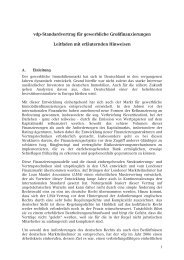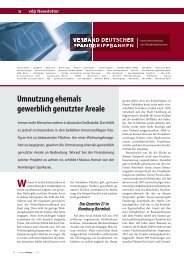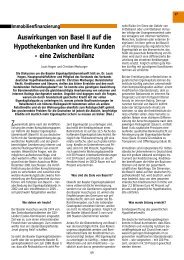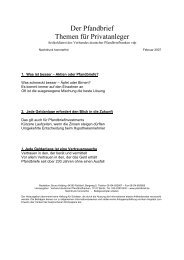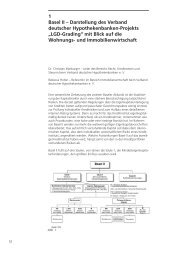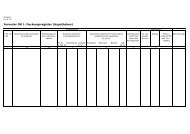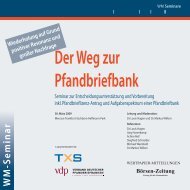The Pfandbrief 2011 | 2012
The Pfandbrief 2011 | 2012
The Pfandbrief 2011 | 2012
Create successful ePaper yourself
Turn your PDF publications into a flip-book with our unique Google optimized e-Paper software.
Quo vadis? <strong>The</strong> regulatory treatment of <strong>Pfandbrief</strong>e under Solvency II<br />
Debt from EEA countries is currently privileged in the area of concentration risk, too. No<br />
concentration risk as such is currently required to be calculated for this debt, regardless of<br />
the actual concentration level. Concentration risk as set out in the standard model only exists<br />
when a threshold representing the maximum acceptable percentage of a single debtor as part<br />
of the overall investment is exceeded. <strong>The</strong> standard model does not include other forms of<br />
concentration, such as geographic concentration or industry concentration, when calculating<br />
the concentration risk.<br />
<strong>The</strong> acceptable threshold generally depends on the rating of the security issued. A maximum<br />
threshold of 15% per counterparty has been established for <strong>Pfandbrief</strong>e and other covered<br />
bonds as set out in the UCITS directive, provided they have a rating of at least AA. If this<br />
percentage is exceeded, QIS5 called for an additional capital requirement of 0.12% for each<br />
additional percentage point by which the threshold is exceeded. <strong>The</strong> additional capital requirement<br />
for <strong>Pfandbrief</strong>e with an A rating was 0.21%, for BBB-rated <strong>Pfandbrief</strong>e it was 0.27%<br />
and for <strong>Pfandbrief</strong>e with an even worse rating it was 0.73%. As with the spread risk, this provides<br />
privileged treatment for <strong>Pfandbrief</strong>e over other fixed-income securities, which only have<br />
thresholds of 3% or 1.5% per issuer.<br />
Summary and Outlook<br />
42<br />
<strong>Pfandbrief</strong>e are a particularly popular asset class for German insurance companies. Around<br />
25% of their total investments were in this product group as at the end of 2010. Whether this<br />
remains so or whether the investment behaviour of insurers will change depends partly on<br />
the future regulatory capital requirements for insurers provided for under Solvency II. <strong>The</strong> delegated<br />
acts and implementing acts, which must be approved before the expected start date of<br />
Solvency II on 1 January 2013, will set out the specific form of the capital requirements.<br />
<strong>The</strong> privileging of the <strong>Pfandbrief</strong> over unsecured corporate bonds and other interestbearing<br />
instruments in the Solvency II standard model shown in the latest Europe-wide impact<br />
study will play a major role in determining whether the German insurance industry can remain<br />
a key investor group. However, the conditions for recognising this privilege are comparatively<br />
high and have thus far not been rigorously implemented. This makes it questionable why it is<br />
only AAA-ratings within the spread risk that enable <strong>Pfandbrief</strong>e to benefit from being privileged.<br />
If the goal is dependency on ratings, it would make sense for this to correspond to the<br />
regulation of the concentration risk and thus be extended to at least include AA-rated <strong>Pfandbrief</strong>e,<br />
if not the entire investment-grade segment.<br />
In spite of a hypothetical expansion of the proposed privilege of <strong>Pfandbrief</strong>e to include<br />
other rating classes, these could become slightly less attractive in comparison to competing<br />
asset classes. This applies in particular to insurers, which have to service very long-term




